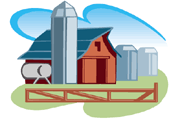Bulletin #2292, Maine Farm Safety Program: Harvest Safety

Bulletin #2292, Maine Farm Safety Program: Harvest Safety (PDF)
By Dawna L. Cyr, farm safety project assistant, and Steven B. Johnson, Ph.D., Extension crops specialist
For information about UMaine Extension programs and resources, visit extension.umaine.edu.
Find more of our publications and books at extension.umaine.edu/publications/.
Good weather and daylight hours always seem to be at a premium when you’re trying to harvest a crop in top condition. Planned maintenance and skilled equipment operation can curb downtime and reduce the potential for accidents during harvest. Preventing accidents is the key to a safe harvest.
The Human Factor
Safe completion of any task depends on knowledge, alertness, and hazard awareness. Fatigue, drowsiness, and illness can lead to a mishap in the field. Recognize when you have had enough, and turn the operation over to someone else.
Adverse weather adds to harvesting pressure. Do not rely on stimulants to keep you going or depressants to calm your nerves. Keen awareness is important to safety; drugs and alcohol work against safety.
- Make sure all guards and shields are in place.
- Instruct all workers in proper technique and safety procedures.
- Stop all moving parts before servicing the machine.
- Keep alert-work safe and smart.
Periodic breaks relieve the monotony of machinery operation. If you are going to eat in the field, at least climb down from the machine and relax for 15 to 20 minutes.
Equipment operators should be dressed for comfort and safety. Protective footwear and close-fitting clothes are essential when working in and around machinery. Wear appropriate safety gear if noise, dust, or toxic materials pose hazards.
Teach workers proper techniques and safety precautions. Enforce safety rules. Allow only age-appropriate work. Follow the no seat, no-rider rule. Do not allow people to board or disembark any moving piece of machinery.
Universal Equipment Cautions
Equipment should be made harvest-ready in the off-season, or at least several weeks before use. It takes time to get machinery into safe, efficient operating condition. You may also need lead time to get replacement parts.
Perform all routine maintenance on schedule. Fuel up and lubricate equipment so it’s ready for the next day. Take steps to prevent condensation and corrosion.
Never clean, oil, or adjust any equipment when it is running. Always make sure the machine has stopped and all moving parts have come to rest to avoid injury.
Secure all guards and shields before starting equipment. These protective devices reduce the chance that people will get caught in moving parts.
Hydraulically raised equipment should be securely blocked before anyone starts working around or under the machine. Do not operate the hydraulic controls from beside or behind the tractor. Operate them only from the tractor seat so you will have full control over the entire machine.
Never attempt to clear plugged equipment by hand while power is engaged. A person can be dragged into the machine in a matter of seconds if the machine suddenly clears itself. Modern equipment is powerful. Entanglement may result in loss of limb or even death. Alert operators develop a habit of shutting off the power before leaving the driver’s seat.
Never stand behind or under the discharge spout of an operating crop harvester. Hard objects coming out of the spout become dangerous projectiles. Completely stop the harvester before hooking up wagons to avoid being hit by objects from the spout.
Fire is a hazard in the field, particularly during grain harvest. Every piece of powered equipment should carry a fire extinguisher.
Do not allow children around machinery. Far too many tragedies occur when youngsters end up in the path of equipment and operators have a restricted view.
Safe harvests begin with the prevention of accidents. Watching the weather and making sure equipment is in the proper working order will help bring in a crop in good condition.
This Maine Farm Safety fact sheet is part of an educational fact sheet series produced by University of Maine Cooperative Extension. For more information on farm safety, contact your UMaine Extension County Office.
Information in this publication is provided purely for educational purposes. No responsibility is assumed for any problems associated with the use of products or services mentioned. No endorsement of products or companies is intended, nor is criticism of unnamed products or companies implied.
© 2003, 2020
Call 800.287.0274 (in Maine), or 207.581.3188, for information on publications and program offerings from University of Maine Cooperative Extension, or visit extension.umaine.edu.
In complying with the letter and spirit of applicable laws and pursuing its own goals of diversity, the University of Maine System does not discriminate on the grounds of race, color, religion, sex, sexual orientation, transgender status, gender, gender identity or expression, ethnicity, national origin, citizenship status, familial status, ancestry, age, disability physical or mental, genetic information, or veterans or military status in employment, education, and all other programs and activities. The University provides reasonable accommodations to qualified individuals with disabilities upon request. The following person has been designated to handle inquiries regarding non-discrimination policies: Director of Equal Opportunity and Title IX Services, 5713 Chadbourne Hall, Room 412, University of Maine, Orono, ME 04469-5713, 207.581.1226, TTY 711 (Maine Relay System).

